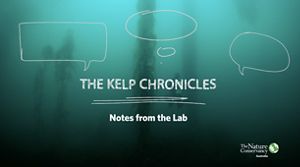Why do we need to help Giant Kelp?
Under the surface of Tasmania’s vast ocean waters, Giant Kelp Macrocystis pyrifera once flourished. These magnificent giants once swayed in vast numbers with the ocean’s currents, flickering gold in the sunlight and skimming along the water’s surface. These trees of the seas can reach up to 40 metres tall and grow at a rapid rate of 50cm a day in the right conditions. However, the once thriving Giant Kelp forests have slowly disappeared, declining by over 95% in Tasmania since the 1970s.
A once vibrant and healthy ecosystem has been impacted by increasingly frequent heatwaves driven by climate change and a strengthening East Australian Current that is driving warm, nutrient-poor water further south. This has meant Giant Kelp has now also suffered in competition alongside other more warm-tolerant seaweed growth taking over.
Where there is kelp there is marine life, and while Sea Urchins are important herbivores in healthy kelp forest habitats, recent explosions in urchin populations have led to overgrazing which has dramatically reduced the extent of kelp forests, not just in Tasmania – but at a global scale.
The restoration of Giant Kelp is crucial to increasing habitat for many of Tasmania’s marine species. A thriving forest improves the health of the coastal ecosystem. Kelp forests can also support a range of incredible biological diversity, including marine invertebrates, fish, mammals and birds. As it grows, Giant Kelp creates complex and productive underwater forests that provide a wide range of ecosystem services, from habitat for commercially valuable species like lobsters, scalefish and abalone, to improving local water quality, buffering coastlines from erosion.
Restoring Giant Kelp forests will also help recreational user groups, like local dive operators (healthy underwater forests are literally huge dive tourism attractions), and commercial fisheries by supporting job creation in regional coastal areas to supplement the developing urchin fishery as a current control method to allow for kelp recovery.
Getting by with a little ‘kelp’ from our friends
We understand the importance and the urgency of reforestation underwater in Tasmania, which is why we’re collaboratively working to help bring back this important ecosystem as part of the Tasmanian Giant Kelp Restoration Project.
The Tasmanian Giant Kelp Restoration Project is a partnership between The Nature Conservancy, the Institute for Marine and Antarctic Studies (IMAS) at The University of Tasmania, Natural Resource Management South (NRM South) and the CSIRO, Australia’s national science agency. The project aims to develop methods for large-scale Giant Kelp restoration and bring together the knowledge, experience and capacity of a wide range of partners and stakeholders to help expand Giant Kelp restoration efforts in Tasmania.
This project will not only benefit the underwater world, but all Tasmanians and visitors by contributing to the recovery of one of the state’s most productive and iconic marine ecosystems. It will create habitat and re-establish lost ground.
The Tasmanian Giant Kelp Restoration Project is made possible by generous funding from Google.org Charitable Giving, the James N Kirby Foundation, and the J and M Wright Foundation.
The Kelp Chronicles
The Kelp Chronicles is a series of mini documentaries charting the innovation and collaboration that is driving this transformative restoration effort.
The road to restoration is filled with challenges, but this journey demands perserverance. Watch now!
Giant Kelp gallery



Each single step toward restoration is a ‘Giant’ leap for reforestation
This collaborative Giant Kelp forest reforestation project will be rolled out in several phases. First, a number of sites will need to be selected for reforestation along the east coast of Tasmania based on a variety of factors. Meanwhile, juvenile kelps will be grown in local hatcheries. Once sites are selected, they will undergo testing for suitability by out-planting these juvenile kelps and comparing their survival and growth across sites.
As the project progresses, our efforts will focus on the most suitable sites. As we work to restore kelp forests, they will be monitored and the lessons learned shared both nationally and globally to help inform restoration efforts in other locations where Giant Kelp has declined, including the coasts of Victoria and South Australia.
How you can help Giant Kelp
TNC is calling on citizen scientists across Tasmania, Victoria, South Australia and New South Wales to help restoration efforts by utilising the web-based platform ‘KelpTracker 2.0’ to support Giant Kelp forest research and recovery efforts.
This is an improved version of the Kelp Tracker app, and will help scientists map historical and present-day data around kelp forests along the coasts of Tasmania and mainland Australia.
You can help provide invaluable information about where Giant Kelp still exists, to help TNC and its partners design and locate restoration projects to make a real and lasting impact.
KelpTracker 2.0 is a partnership between The Nature Conservancy, the Victorian National Parks Association, the Institute for Marine and Antarctic Studies (IMAS) at the University of Tasmania and OzFish Unlimited.
Kelp Tracker 2.0
Read more about KelpTracker 2.0 and start using it to help us find Giant Kelp forest locations: OPEN KELP TRACKER 2.0





